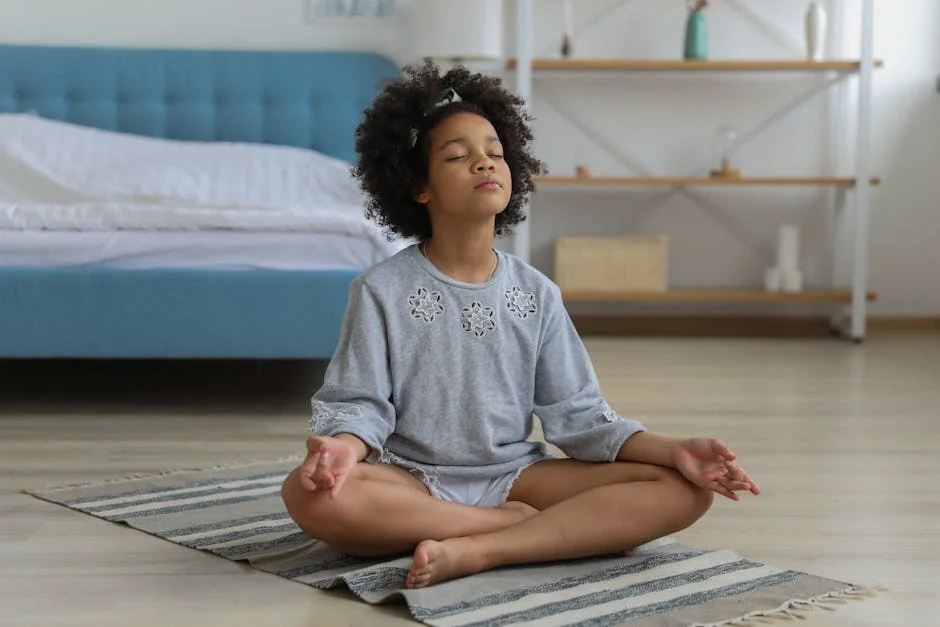Feeling like your brain is a browser with 100 tabs open at once? You’re not alone. In our non-stop world, finding a moment of quiet can feel impossible. But what if you could learn to close those tabs, reduce the noise, and find a genuine sense of calm? The good news is, you can, and it doesn’t require any special equipment or hours of your time. This beginner-friendly meditation tutorial is your first step off the mental hamster wheel.
Forget any preconceived notions—this isn’t about emptying your mind or achieving enlightenment overnight. Instead, we’ll walk you through the foundational skills of meditation in a simple, step-by-step way. This guide is designed to demystify the practice, showing you exactly how to start, how to handle a wandering mind, and how to build a sustainable habit. Get ready to unlock proven benefits like reduced stress, sharper focus, and better sleep. Let’s begin your journey to a calmer, more centered you.
Why Meditate? The Science-Backed Benefits for Mind and Body
You might have heard that meditation is good for you, but the sheer volume of scientific evidence backing this claim is staggering. This isn't just spiritual fluff; it's a practical mental workout with tangible, real-world rewards. Understanding the "why" fuels motivation, turning a vague "should do" into an exciting "can't wait to do."
Mental Clarity & Focus Think of your attention as a muscle. Every time you compulsively check your phone or multitask, you're straining that muscle. Meditation is like a weightlifting regimen for your focus. It trains your brain to notice when it has drifted and to deliberately bring it back to a single point, like the breath. Studies show that regular practice can thicken the prefrontal cortex, the part of your brain responsible for decision-making and attention. The result? You’ll find it easier to concentrate on work, listen in conversations, and pull yourself out of distracting thought loops.
Stress & Anxiety Reduction This is perhaps the most sought-after benefit, and for good reason. When you encounter stress, your body releases cortisol and flips the "fight-or-flight" switch (the sympathetic nervous system). Meditation directly counters this. It activates the body's relaxation response (the parasympathetic nervous system), slowing your heart rate, lowering blood pressure, and calming your breathing. Over time, you rewire your brain's stress pathways, becoming less reactive to triggers and more resilient in the face of life's inevitable challenges.
Improved Emotional Health Meditation doesn't eliminate difficult emotions; it changes your relationship with them. Instead of being swept away by a wave of anger or sadness, you learn to sit on the shore and watch the wave come and go. This practice, often called mindfulness, creates a crucial space between a triggering event and your reaction. You gain the clarity to ask, "Do I need to respond to this, or can I just let it pass?" This leads to greater emotional intelligence, less impulsivity, and a more balanced outlook on life. If you're specifically looking to cultivate positive emotions, a feel good meditation practice can be incredibly effective.
Enhanced Sleep Quality Struggling with insomnia or restless nights? A racing mind is often the culprit. Meditation helps quiet that internal chatter. By practicing mindfulness or body-scan techniques before bed, you calm your nervous system and shift your body into a state conducive to sleep. Research has shown that mindfulness meditation can be as effective as sleep medication for some people struggling with chronic insomnia, but without the side effects.
Preparing for Your Practice: A Simple Pre-Meditation Checklist
Jumping into meditation without a little preparation is like trying to bake a cake without preheating the oven—it might work, but the results won't be ideal. This simple checklist ensures you set yourself up for success, removing common barriers before they even arise.
Finding Your Space You don't need a dedicated meditation room. You just need a small, relatively quiet corner where you won't be interrupted for a few minutes.
- A chair in your bedroom before anyone else is awake.
- A cushion in the living room after the kids have left for school.
- Even your parked car during a lunch break. The goal is consistency, so a consistent spot helps signal to your brain that it's time to settle down.
Timing is Everything The "best" time to meditate is whenever you can do it consistently.
- Morning: Practicing first thing can set a calm, intentional tone for your entire day.
- Evening: Meditating can help you process the day's events and transition into a more restful state. Start with a ridiculously small goal. Five minutes is perfect. It's far better to meditate for five minutes every day than for 30 minutes once a week. Consistency builds the habit. If you're curious about the impact of a longer session, you can read about one person's twenty minutes meditation journey.
Choosing a Posture Forget the full-lotus pose if it isn't comfortable. The ideal posture is alert yet relaxed.
- In a Chair: Sit upright with your feet flat on the floor and your back supported. Avoid slouching against the backrest.
- On a Cushion: Sit cross-legged, ensuring your hips are slightly higher than your knees for spinal support.
- The Key Principle: Keep your spine straight, as if a string is gently pulling the crown of your head toward the ceiling. This posture promotes alertness. Rest your hands comfortably on your knees or in your lap.
Helpful Tools Keep it simple. The only tool you truly need is a timer.
- Timer: Use your phone (on silent/do not disturb mode) or a simple kitchen timer. A gentle, non-startling alarm is ideal.
- Cushion/Pillow: A firm meditation cushion (zafu) or a folded blanket can make sitting on the floor more comfortable.
- Blanket: Your body temperature can drop when you sit still, so having a light blanket nearby is helpful.
Your First Meditation: A Step-by-Step Beginner's Tutorial
This is the core of your meditation guide. Read through these steps once, then set a timer for five minutes and give it a try. Don't worry about doing it "right." The simple act of trying is a success.
Step 1: Get Settled Find your chosen spot and settle into your posture. Gently close your eyes or lower your gaze to a spot on the floor a few feet in front of you. Take two or three slow, deep breaths. Sigh out loud on the exhale if it feels good. This helps release initial physical tension.
Step 2: Anchor Your Attention Bring your attention to the physical sensation of your breath. You don't need to control it or make it deeper. Just notice it.
- Feel the air entering your nostrils.
- Notice the rise and fall of your chest or the expansion and contraction of your belly. Choose one of these sensations as your "anchor." Your breath is your home base throughout this practice.
Step 3: Notice When Your Mind Wanders Within a few seconds, your mind will wander. This is not a mistake; it is the entire point of the exercise. You might start thinking about your to-do list, a conversation you had, or what you’ll make for dinner. The moment you realize your mind is no longer on your breath, gently acknowledge it. You can even silently say to yourself, "thinking," or "wandering."
Dealing with a Busy Mind: The "Just Notice and Return" Technique
This is the most critical skill in this entire meditation tutorial. The magic isn't in stopping your thoughts; it's in the act of noticing you've wandered and choosing to return. This repetitive action is like a bicep curl for your brain. Each return is a rep that strengthens your focus and mindfulness muscles. Be kind and patient with yourself during this process. There is no limit to the number of times you can gently guide your attention back. For a guide specifically designed to help with this, see our post on meditation to clear your mind.
Step 4: Gently Return After noticing your mind has wandered, guide your attention back to the sensation of the breath. Do this without any judgment or self-criticism. There's no need to get frustrated. The act of noticing and returning is the practice itself.
Step 5: Closing the Session When your timer chimes, don't jump right up. Allow yourself a moment to transition. Slowly expand your awareness back to your body. Notice the feeling of your feet on the floor, your hands in your lap. Listen to the sounds in the room around you. Gently blink your eyes open. Take a final moment to appreciate yourself for taking this time for your well-being.
Exploring Different Meditation Techniques to Find Your Fit
Once you're comfortable with the basic breath-focused practice, you might wonder what else is out there. There are many paths up the same mountain. Exploring different styles can keep your practice fresh and help you discover what resonates most with you.
Loving-Kindness Meditation (Metta) This practice is aimed at cultivating feelings of goodwill, kindness, and warmth towards yourself and others.
- How it works: You silently repeat a series of phrases, directing them first to yourself, then to a loved one, a neutral person, a difficult person, and finally to all beings.
- Sample phrases: "May I be happy. May I be healthy. May I be safe. May I live with ease."
- Ideal for: Counteracting negative self-talk, increasing empathy, and fostering a sense of connection.
Body Scan Meditation This technique involves systematically moving your attention through different parts of your body.
- How it works: You start at the toes, noticing any sensations—tingling, warmth, tension, or nothing at all—without trying to change anything. You then slowly move your attention up through your feet, legs, torso, arms, and all the way to the crown of your head.
- Ideal for: Relieving physical tension, grounding yourself in the present moment, and helping with sleep.
Walking Meditation If sitting still is too challenging, walking meditation is a fantastic alternative. It turns a simple activity into a profound practice.
- How it works: Find a quiet path where you can walk 10-20 paces back and forth. Focus all your attention on the physical experience of walking. Feel the lift of your foot, the movement through space, and the placement of your foot back on the ground.
- Ideal for: People who get restless during seated meditation, and for integrating mindfulness into daily movement.
Common Meditation Challenges and How to Overcome Them
Every meditator, from beginner to monk, faces challenges. Anticipating them removes their power and helps you see them as part of the path, not as signs you're failing.
"I Can't Stop My Thoughts" This is the most common misconception. The goal is not to stop thoughts, but to change your relationship with them. Imagine your mind is a clear blue sky, and your thoughts are just clouds passing by. You don't have to stop the clouds; you can just watch them drift past without getting caught up in them.
Falling Asleep If you're falling asleep, it often means you need more rest! It can also be a sign of a too-relaxed posture.
- Try: Meditating with your eyes slightly open, focusing on a spot on the floor.
- Adjust: Sitting more upright, even on the edge of your chair, to promote alertness.
- Consider: Meditating at a different time of day when you're more naturally alert.
Physical Discomfort Some stillness-related discomfort is normal. Sharp or intense pain should be addressed.
- Adjust: Use more cushions for support. If sitting cross-legged hurts, sit in a chair.
- Move: It's perfectly okay to make small adjustments during your meditation. Move slowly and mindfully.
Getting Discouraged Progress in meditation is not linear. Some days your mind will feel calm; other days it will be a whirlwind. This is normal. The key is to not let a "bad" session deter you. Showing up is 90% of the battle. Every single time you sit down, you are reinforcing the habit and strengthening your mind. To see how the journey can unfold, you might be inspired by this meditation experience of practicing for three months.
Building a Lasting Habit: Integrating Meditation into Your Life
The true transformation from meditation comes from consistent practice. Turning it from a novel activity into a non-negotiable part of your day, like brushing your teeth, is the final piece of the puzzle.
Start Small and Be Consistent Commit to just five minutes a day for one week. Link your practice to an existing habit to make it stick—a technique called "habit stacking." For example: "After I pour my morning coffee, I will meditate for five minutes." This built-in trigger makes it much easier to remember and execute.
Track Your Progress Use a calendar or a habit-tracking app. Put a big "X" on every day you meditate. This visual chain is powerfully motivating—you won't want to break the chain!
Find a Community Meditation can feel solitary. Consider using a guided meditation app for a sense of structure and community. Joining a local or online meditation group can provide support, motivation, and valuable guidance.
Be Kind to Yourself Some days you will miss a session. This is not failure. This is life. The practice of meditation is, at its heart, a practice of radical self-compassion. When you miss a day, simply acknowledge it without judgment and gently guide yourself back to your practice the next day, just as you guide your attention back to your breath.
In closing, the journey into meditation is an accessible and profoundly rewarding practice for anyone seeking greater mental clarity and emotional balance. This guide has equipped you with the foundational tools: from establishing a consistent routine and mastering basic breathing techniques to navigating common challenges like a wandering mind. The core message is that meditation’s benefits—reduced stress, enhanced focus, and a deeper sense of inner peace—are not reserved for experts but are available to all who practice with patience and self-compassion. Consistency matters far more than perfection. Begin with just a few minutes each day, be gentle with your progress, and trust in the process. You now possess the knowledge to build a sustainable practice that can transform your daily life. Take that first, simple step today, and embark on a path toward a calmer, more centered you.



